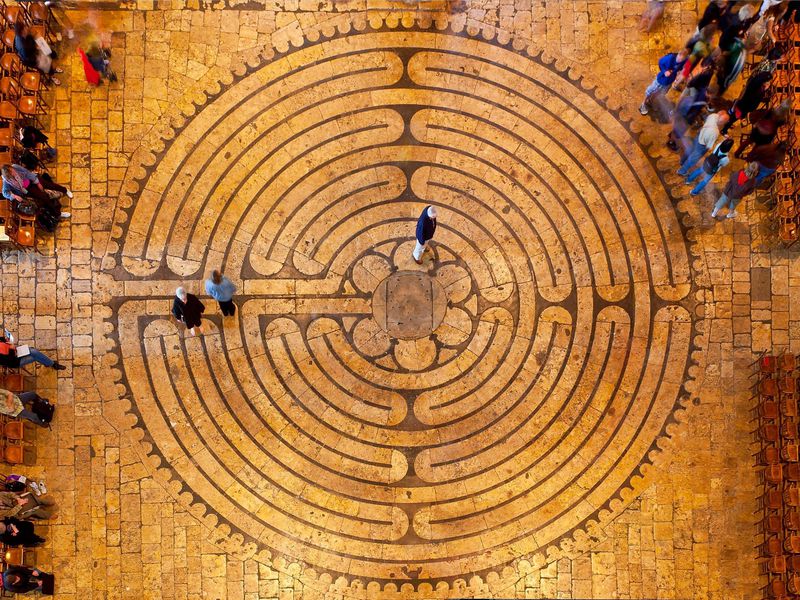
10 - Labyrinth at Dromcollogher
The Labyrinth - A Sacred Path. This labyrinth is placed directly on the site of the former Dromcollogher Parochial House, home to Hugh Canon O’Connor, John Canon Liston and Seamus Canon Ambrose. The design and layout of this Labyrinth is based on the labyrinth of the Cathedral Notre Dame of Chartres, the town in France, about 80 km (50 miles) southwest of Paris. The Chartres labyrinth was probably built 1215-1235. This was when pilgrimage to the Holy City of Jerusalem was made difficult and dangerous by the Crusades. The Church designated seven European cathedrals, mainly in France, to become “Jerusalem” for pilgrims. The labyrinth became the final stage of pilgrimage, serving as a symbolic entry into the Celestial City of Jerusalem.
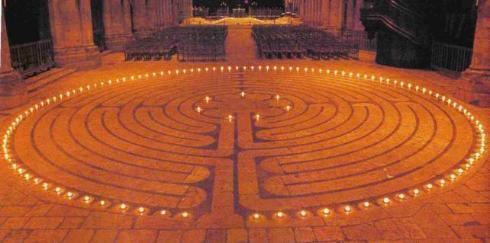
The floor of the nave at Chartres Cathedral with the seating removed to reveal the paved Labyrinth with illuminations.
Like all the original seven cathedrals, this labyrinth in Dromcollogher used the 11-circuit design. The 11-circuit labyrinth has an asymmetrical, mathematically and visually complex pattern in which every quadrant is different. The path twists and turns so that you move towards the centre and out again – as if towards and away from God. Senior church authorities in 13th century France gave master builders at Chartres details of the special numbers and symbolism on which they must base their design resulting in this sacred geometry which provided a means of communicating complex theological meaning.
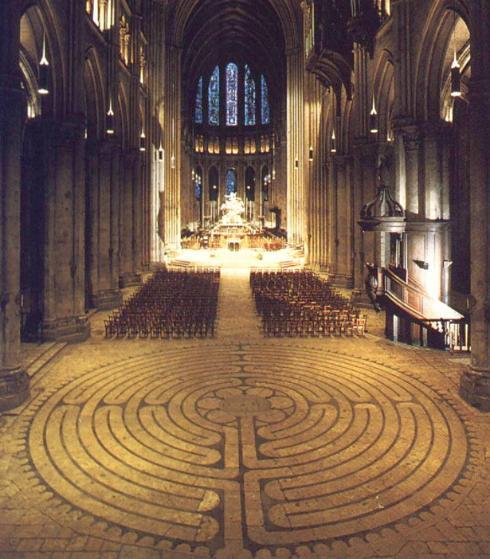
Another view of the Chartres Labyrinth of which the Dromcollogher Labyrinth is a replica.
A labyrinth is not to be confused with a maze. A maze is a deliberately confusing intricate network of passages, often leading to a state of bewilderment. It is like a puzzle that must be solved by thinking your way through the false paths and dead ends. In contrast, a labyrinth, such as this, is an easy to follow, meandering, spiralling, circular path, leading to and from the centre. There is only one path inwards, and then, by reversing, the same path leads back out again. It stimulates creativity, inspiration, and intuition.
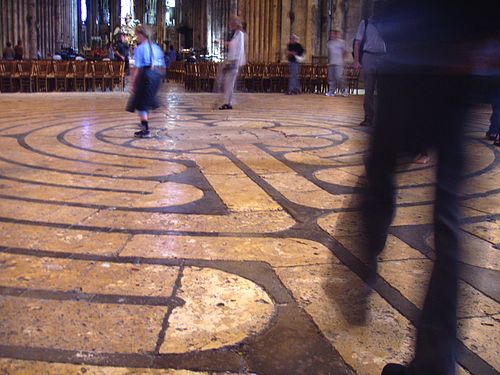
Walking the Labyrinth.
Labyrinths are found in all religious traditions in various forms around the world. Labyrinths and labyrinthine symbols have been dated to the Neolithic Age in regions as diverse as modern-day Turkey, Ireland, Greece, and India among others. The Labyrinth is central to some famous Greek mythology such as the Labyrinth of Knossos in Crete. In the Tantric texts of India, the labyrinth is often featured in the design of mandalas while in Britain and Ireland they are pre-figured in the ring-and-cup marks often found in stone work and the famous swirl designs found at sites such as Newgrange.
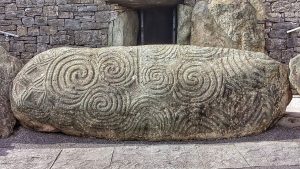
Variation on the labyrinthine theme as represented on the ancient carvings at UNESCO World Heritage site at Newgrange, Co Meath.
By walking this replica of the one of the best examples of a Medieval Pavement Labyrinth, the Chartres labyrinth, a long-forgotten mystical tradition of open-eyed active meditation can be rediscovered here.
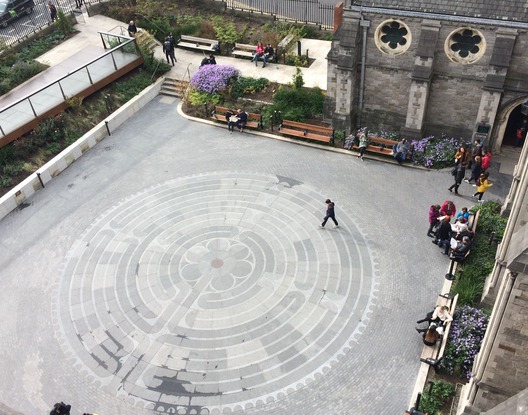
The Labyrinth at Christ Church Cathedral, Dublin is also an outdoor brick/paver, Medieval Chartres replica.
Going beyond the more classical seven-circuit Cretan labyrinth, the Medieval Chartres Labyrinth style replicated here is an eleven-circuit design, dived into four quadrants, and encircled by an outer ring of Lunations (the ‘cogs’ on the wheel). It is about 42 feet or 12.9 meters in diameter and the walk in to the centre and back out again is a distance of about one third of a mile!

DCU Glasnevin is also home to a labyrinth: a physical space designed to aid reflection and self-centring.
The quadrants bring to mind the even armed cross.
The spiritual centre goal, the resting place, is defined by a Rosette pattern of 6 petals, open to the centre, reminiscent of the sacred lotus, symbol of Enlightenment. Also, the rose of six petals may remind the name "Mystic Rose" for Mary, popular in the Middle Ages. Although the natural rose has only five petals, here the number six was probably chosen to demonstrate perfection. A six lobed rosette may also have been an ancient symbol from the east used to portray the nature of God in Sumerian, Babylonian, Jewish, and even Roman art.

Glencomeragh House, a retreat and conference centre in Kilsheelan, Co. Tipperary can be visited by appointment to view the sandstone and limestone Medieval Chartres replica labyrinth.
3 Stages of walking the Labyrinth:-
Purgation (Releasing) Quiet your mind and release the burden of life. While walking to the centre open your heart and trust that God will be at your side during the walk.
Illumination (Receiving) Upon entering the centre of the labyrinth, feel free to stand or sit and to spend as much time as you want or need in the centre. This is the time to quiet your mind and just listen. Open your soul to God’s unconditional love and you shall receive it.
Union (Returning) Your journey out of the labyrinth is the time to integrate the experience of your walk and God’s message into your soul and life. Walk at a pace that feels comfortable to you.
The mystics of old spoke often of purgation (or katharsis) as the portal to illumination (or fotosis) and union (or theosis).
Labyrinths in other parts of the world:

Labyrinth at the Old Summer Palace, also referred to as Yuanmingyuan, located in the outskirts of Beijing, China.
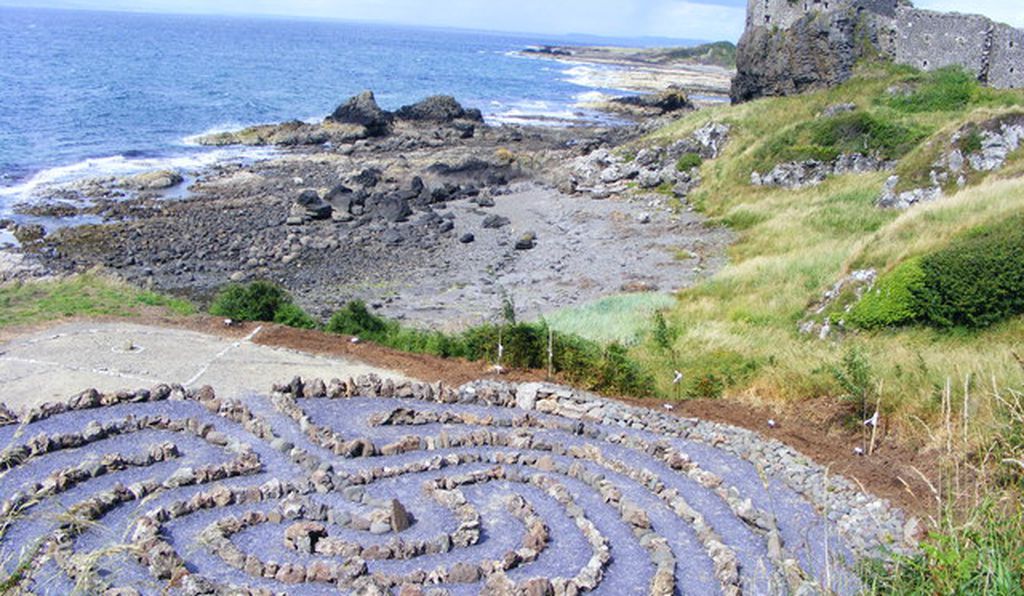
A rock labyrinth at Dunure Castle, Scotland.
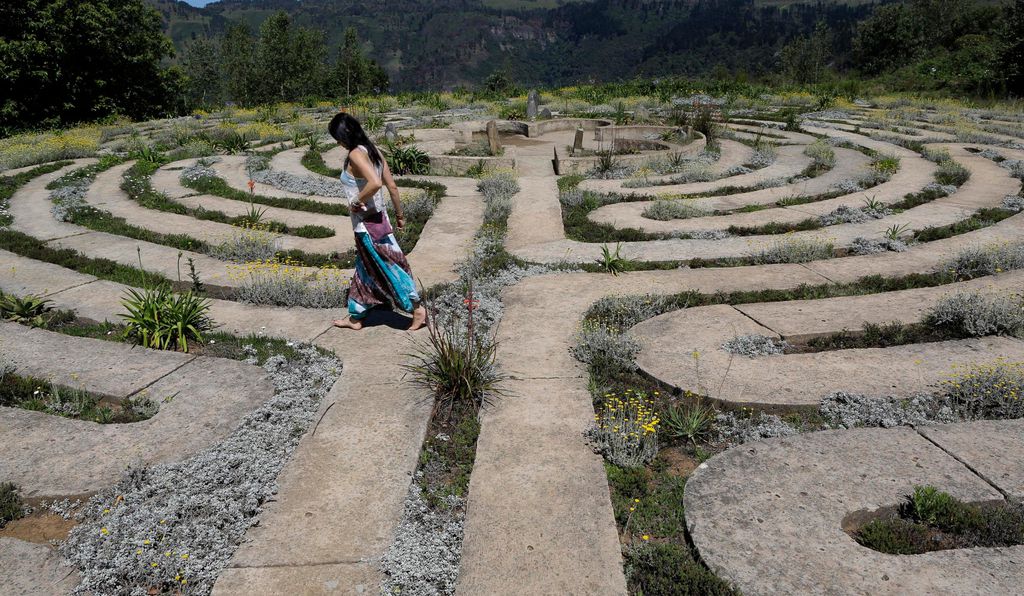
The Labyrinth at The Edge Mountain Retreat at Hogsback, in the Amathole Mountains, SouthAfrica
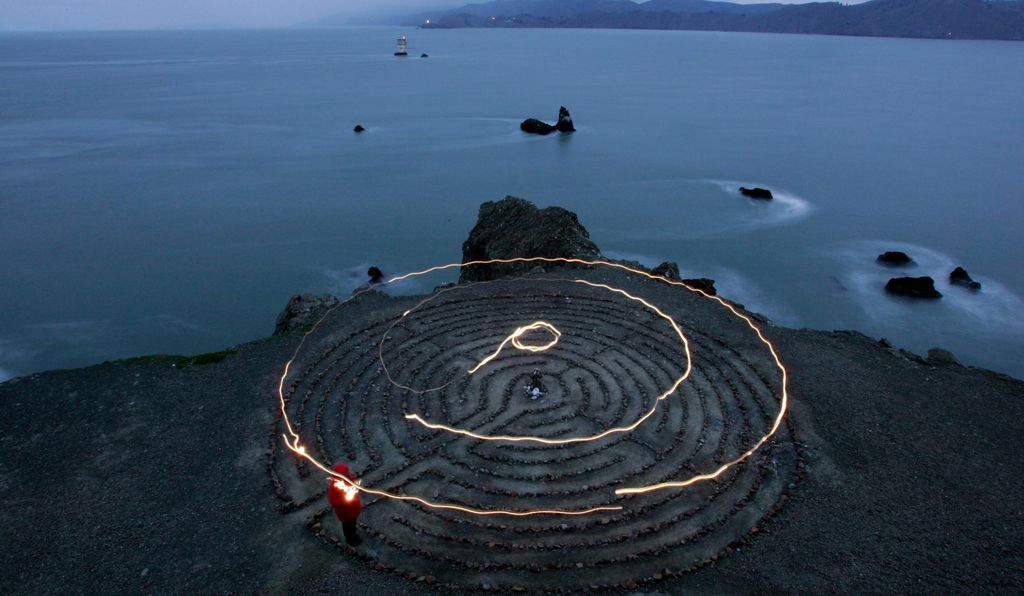
An 11 Circuit labyrinth located on a bluff overlooking Mile Rock Beach at Land's End, in San Francisco, California.
Acknowledgements:
- Smithsonian Magazine
- Joshua J. Mark
- World Wide Labyrinth Locator
- Fr Frank O’Dea